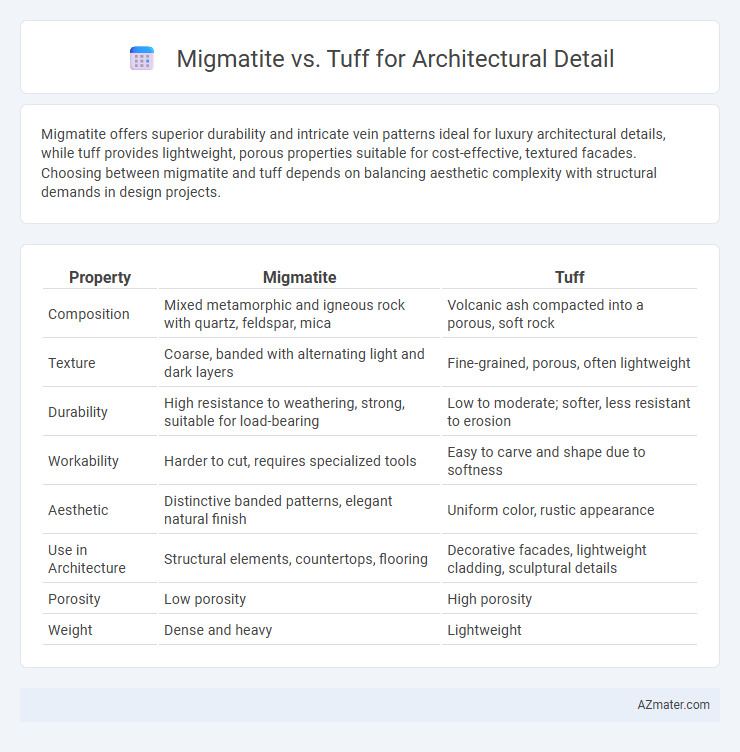Migmatite offers superior durability and intricate vein patterns ideal for luxury architectural details, while tuff provides lightweight, porous properties suitable for cost-effective, textured facades. Choosing between migmatite and tuff depends on balancing aesthetic complexity with structural demands in design projects.
Table of Comparison
| Property | Migmatite | Tuff |
|---|---|---|
| Composition | Mixed metamorphic and igneous rock with quartz, feldspar, mica | Volcanic ash compacted into a porous, soft rock |
| Texture | Coarse, banded with alternating light and dark layers | Fine-grained, porous, often lightweight |
| Durability | High resistance to weathering, strong, suitable for load-bearing | Low to moderate; softer, less resistant to erosion |
| Workability | Harder to cut, requires specialized tools | Easy to carve and shape due to softness |
| Aesthetic | Distinctive banded patterns, elegant natural finish | Uniform color, rustic appearance |
| Use in Architecture | Structural elements, countertops, flooring | Decorative facades, lightweight cladding, sculptural details |
| Porosity | Low porosity | High porosity |
| Weight | Dense and heavy | Lightweight |
Introduction to Migmatite and Tuff in Architecture
Migmatite, a composite rock formed under intense heat and pressure, offers a unique blend of metamorphic and igneous textures, making it a highly durable and visually striking material for architectural detailing. Tuff, composed of consolidated volcanic ash, provides lightweight and porous characteristics ideal for decorative facades and intricate carvings, reflecting its historic use in classical architecture. Both materials contribute distinct aesthetic and structural qualities that influence design choices in modern and traditional construction projects.
Geological Formation of Migmatite
Migmatite forms through partial melting of pre-existing metamorphic rocks under high temperatures and pressures, resulting in a complex, layered structure that combines igneous and metamorphic characteristics, making it durable and visually intricate for architectural detailing. In contrast, tuff originates from volcanic ash deposits that have compacted and cemented over time, producing a lighter, more porous material often used for ornamental facades but less suited for structural integrity. The geological formation of migmatite offers superior mechanical strength and unique banding patterns, enhancing both aesthetic appeal and longevity in architectural applications.
Geological Formation of Tuff
Tuff, formed from consolidated volcanic ash ejected during explosive eruptions, exhibits a porous texture ideal for architectural details requiring lightweight yet durable material. In contrast, migmatite results from partial melting of metamorphic rocks under extreme heat and pressure, producing a banded, heterogeneous structure unsuitable for intricate design elements. The volcanic origin of tuff allows for easier carving and weather resistance, making it a preferred choice in historic and contemporary architecture.
Physical and Aesthetic Properties Comparison
Migmatite exhibits high durability and a unique swirling pattern caused by partial melting, providing a sophisticated, natural stone appearance ideal for intricate architectural details. Tuff, a porous volcanic rock, offers lightweight properties and a rough texture that enhances rustic or Mediterranean-style designs but may require sealing for weather resistance. Both stones deliver distinct aesthetic qualities; migmatite emphasizes elegance and strength, while tuff prioritizes texture and thermal insulation benefits.
Durability and Weather Resistance
Migmatite offers superior durability and weather resistance due to its amalgamation of igneous and metamorphic rock properties, making it highly resistant to erosion and structural degradation in harsh climates. Tuff, while lightweight and easier to quarry, is less durable and more susceptible to weathering, especially in wet or freeze-thaw conditions, limiting its suitability for long-term exterior architectural details. Architects favor migmatite for projects requiring robust, weather-resistant stone that maintains both aesthetic appeal and structural integrity over time.
Workability and Ease of Fabrication
Migmatite offers superior workability due to its mixed metamorphic and igneous composition, allowing for intricate architectural detailing and smooth finishes. Tuff, being a volcanic rock, is softer and easier to cut, making it ideal for rapid fabrication but less durable under heavy loads. Choosing between migmatite and tuff depends on balancing detailed design requirements with fabrication speed and long-term structural performance.
Color Variations and Visual Impact
Migmatite offers a rich color palette ranging from creamy whites and light grays to deep blues and greens, creating a dynamic and visually striking effect in architectural details. Tuff, formed from volcanic ash, typically presents earthy tones such as soft browns, reds, and yellows, providing a warm, textured appearance that enhances rustic or naturalistic designs. The visual impact of migmatite lies in its swirling, banded patterns that add depth and complexity, whereas tuff's porous surface and consistent coloration contribute to a more uniform and subdued aesthetic.
Suitability for Interior and Exterior Details
Migmatite, known for its high durability and natural aesthetic, excels in exterior architectural details due to its resistance to weathering and ability to maintain structural integrity over time. Tuff, a volcanic rock with a softer texture, is more suitable for interior architectural details where ease of carving and lighter weight are advantageous, but it requires protective treatments for exterior use to prevent erosion. Both materials offer unique visual textures, but migmatite is preferred for high-traffic outdoor applications, while tuff is favored for decorative indoor features.
Cost and Availability Considerations
Migmatite, a high-grade metamorphic rock with unique banded patterns, tends to be more expensive and less readily available due to its limited quarry locations and complex extraction process. Tuff, a volcanic ash-based rock, offers a more cost-effective and widely accessible option, ideal for architectural details requiring lightweight and porous materials. When selecting between migmatite and tuff, considerations of budget constraints and regional stone availability significantly influence project feasibility and design decisions.
Environmental Impact and Sustainability
Migmatite offers superior durability and thermal stability, reducing maintenance frequency and the need for resource-intensive replacements, which supports sustainable building practices. Tuff, a volcanic ash stone, is lightweight and highly porous, providing excellent insulation properties that enhance energy efficiency in structures and lower heating and cooling demands. Both materials contribute to environmentally conscious architecture, with migmatite excelling in longevity and tuff optimizing energy consumption through natural insulation.

Infographic: Migmatite vs Tuff for Architectural Detail
 azmater.com
azmater.com